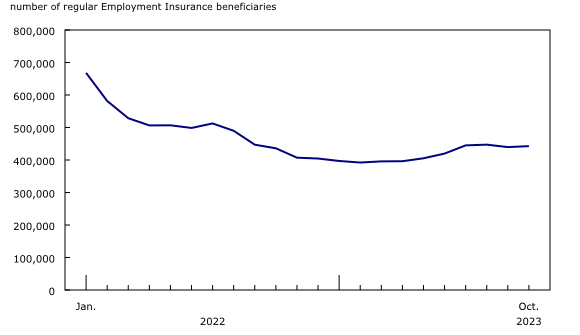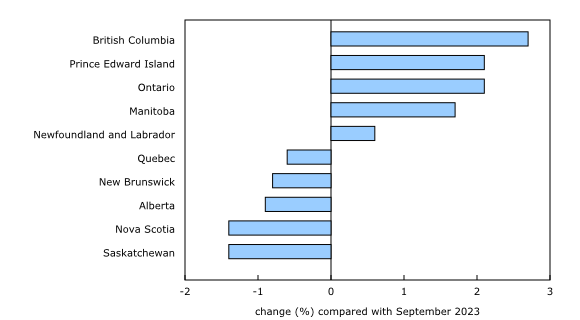Employment Insurance, October 2023
Released: 2023-12-20
The number of Canadians receiving regular Employment Insurance (EI) benefits was little changed in October (+0.7%; +2,900) and stood at 443,000. Considering this little variation, little change was observed over the last three months, after three consecutive monthly increases that ended in July. On a year-over-year basis, the number of regular EI beneficiaries increased by 6,500 (+1.5%) in October.
Data from the Labour Force Survey (LFS) show that the unemployment rate rose 0.2 percentage points to 5.7% in October, marking the fourth monthly increase in the last six months.
In general, variations in the number of beneficiaries can reflect changes in the circumstances of different groups, including those becoming beneficiaries, those going back to work, those exhausting their regular benefits, and those no longer receiving benefits for other reasons.
More regular Employment Insurance recipients in British Columbia, Ontario, Prince Edward Island and Manitoba and fewer in Nova Scotia and Saskatchewan
In October, the number of regular EI beneficiaries increased in British Columbia (+2.7%; +1,300), Ontario (+2.1%; +2,600), Prince Edward Island (+2.1%; +100) and Manitoba (+1.7%; +300) and decreased in Nova Scotia (-1.4%; -300) and Saskatchewan (-1.4%; -200). There was little change in the other provinces.
British Columbia saw more regular EI recipients (+2.7%; +1,300) in October, the fifth consecutive monthly increase. The LFS showed that the unemployment rate in British Columbia was 5.4% in October; this is unchanged from September but up 1.3 percentage points from the low of 4.1% recorded in December 2022. Increases in regular EI recipients in October 2023 were mainly among core-aged (25 to 54 years) men (+3.6%; +700) and women (+2.4%; +300) and among men aged 55 years and older (+1.9%; +100). Most of the increase in EI recipients was in the census metropolitan area (CMA) of Vancouver (+4.9%; +1,200).
In Ontario, the number of regular EI recipients rose by 2,600 (+2.1%) in October, the second increase in the last three months. The largest increases in the number of regular EI beneficiaries in October were among core-aged men (+3.5%; +1,700) and men aged 55 years and older (+4.7%; +800). In the CMA of Windsor, the number of regular EI recipients increased by 3,300 (+89.1%) in October, coinciding with a notable increase in the unemployment rate (+1.1 percentage points) (three-month average). As of October, Windsor had the highest unemployment rate (7.1%) among all CMAs in the country (three-month average).
Following little change in August and September, Prince Edward Island posted an increase in the number of regular EI recipients (+2.1%; +100) in October. The increase was among core-aged men (+5.7%; +100).
There were also more EI recipients in Manitoba (+1.7%; +300) in October, partly offsetting a decline (-7.2%; -1,200) in the previous month. The increase was among core-aged men (+4.0%; +200).
In contrast, the number of regular EI beneficiaries fell in October in Nova Scotia (-1.4%; -300) and Saskatchewan (-1.4%; -200).
Fewer older women, but more core-aged men, receive regular Employment Insurance benefits
Following increases in July and August, the number of women aged 55 years and older receiving regular EI benefits fell (-2.7%; -1,100) in October, the second consecutive monthly decline. Compared with October 2022, the number of women aged 55 years and older receiving regular EI benefits fell by 5,800 (-12.4%).
In contrast, the number of men aged 25 to 54 years receiving regular EI benefits increased in five of the last six months and was up by 3,200 (+1.8%) in October. On a year-over-year basis, the number of core-aged men receiving regular EI benefits rose by 13,000 (+8.0%).
There was little change in the number of EI recipients in the other major demographic groups in October.
Sustainable Development Goals
On January 1, 2016, the world officially began implementing the 2030 Agenda for Sustainable Development—the United Nations' transformative plan of action that addresses urgent global challenges over the following 15 years. The plan is based on 17 specific sustainable development goals.
Employment Insurance statistics are an example of how Statistics Canada supports reporting on global sustainable development goals. This release will be used to help measure the following goal:

Note to readers
Availability of data by occupation
Statistics Canada is currently revising the Employment Insurance Statistics (EIS) data to conform to the 2021 National Occupational Classification (NOC) standard. This will result in EIS occupation categories aligning with the 2021 Census of Population and Labour Force Survey NOC 2021 categories. The release of revised data is planned for later in 2024. Until then, information on Employment Insurance (EI) beneficiaries by occupation, including tables 14-10-0336-01 and 14-10-0337-01, will not be available.
Concepts and methodology
EI statistics are produced from administrative data sources provided by Service Canada and Employment and Social Development Canada. These statistics may, from time to time, be affected by changes to the Employment Insurance Act or administrative procedures.
EI statistics indicate the number of people who received EI benefits and should not be confused with Labour Force Survey (LFS) data, which provide estimates of the total number of unemployed people. There is always a certain proportion of unemployed people who do not qualify for benefits. Some unemployed people have not contributed to the program because they have not worked in the past 12 months or their employment was not insured. Other unemployed people have contributed to the program, but do not meet the eligibility criteria, such as workers who left their jobs voluntarily or those who did not accumulate enough hours of work to receive benefits.
All data in this release are seasonally adjusted, unless otherwise specified. To model the effects of the COVID-19 pandemic, values for all series from March 2020 to November 2021 have been treated with a combination of level shifts and outliers to determine a seasonal pattern for seasonal adjustment. For more information on seasonal adjustment, see Seasonally adjusted data – Frequently asked questions.
The number of regular EI beneficiaries for the current month and the previous month is subject to revision.
The number of beneficiaries is all people who received regular EI benefits from October 8 to 14, 2023. This period coincides with the reference week of the LFS.
A census metropolitan area (CMA) and a census agglomeration (CA) are formed by one or more adjacent municipalities centred on a population centre. A CMA must have a total population of at least 100,000. A CA must have a population of at least 10,000. See Standard Geographical Classification 2016 – Definitions for more information.
Next release
Data on EI for November will be released on January 19, 2024.
Products
More information about the concepts and use of Employment Insurance statistics is available in the Guide to Employment Insurance Statistics (73-506-G).
Contact information
For more information, or to enquire about the concepts, methods or data quality of this release, contact us (toll-free 1-800-263-1136; 514-283-8300; infostats@statcan.gc.ca) or Media Relations (statcan.mediahotline-ligneinfomedias.statcan@statcan.gc.ca).
- Date modified:




